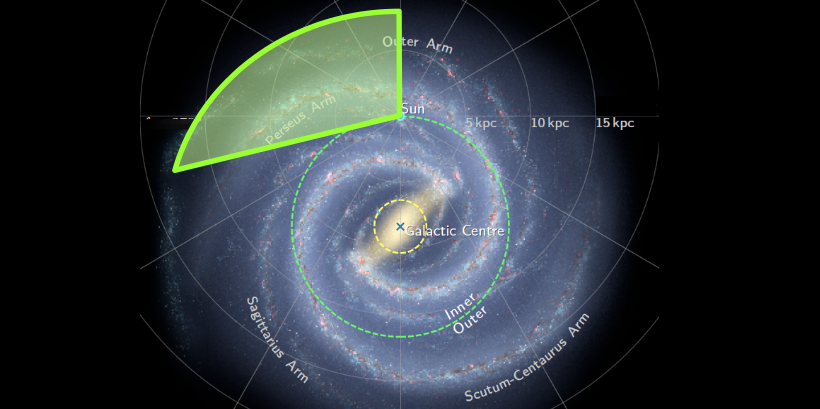
New observations of the outer Milky Way help to understand the star formation process
27-03-2024
Having an accurate understanding of the star formation process is essential to comprehend the formation and evolution of galaxies, and this requires to unveil the impact of environment on star formation. In a new study published in Monthly Notices of the Royal Astronomical Society, scientists used a new survey of the outer Galaxy to refine the distance and properties of star-forming clumps and study how star formation behave in comparison with the inner Galaxy.
How stars are forming is currently not well understood, due to the multiple factors on which star formation depends (metallicity, density, radiation field). Observations in the Milky Way can help us in that matter as different locations along the Galactocentric radius show different environmental conditions. Such observations are necessary to understand not only how star formation takes place in our Galaxy but also how galaxies form and evolve since pc-scale resolution cannot be reached for high-redshift galaxies, which is crucial to accurately depict the star formation process.
In a recent work published in the journal Monthly Notices of the Royal Astronomical Society, a team of scientists has made use of the Outer Galaxy High Resolution Survey (OGHReS) to refine the distance and properties of star-forming clumps and to examine the impact of the environment. The research include Dr Miguel Figueira, a post-doc at the National Centre for Nuclear Research (NCBJ) and Principal Investigator of the SONATA NCN project „The impact of massive stars: from the Milky Way to nearby galaxies”.
OGHReS is a spectroscopic survey of the outer Galaxy (~1300 hours) performed with the Atacama Path Finder Experiment (APEX) telescope in Chile and covers an area of 100deg^2 (180°<l<280°) with a resolution of 27”. The survey mainly uses spectral lines of 12CO, 13CO and C18O isotopologues to trace the molecular gas in the interstellar medium.
„This work focuses on a portion of the survey (250°<l<280°) where the distance from 3412 star-forming clumps from the Herschel Infrared Galactic Plane Survey was refined” – describes Dr Miguel Figueira from the Astrophysics Division of NCBJ. „Accurate measurement of the distance is primordial as several physical parameters depend on it (e.g., luminosity or the mass) and having wrong estimations of these physical parameters would lead to incorrect conclusions about the impact of environment.”
In total, 20% has updated distance estimations and another 20% has new distance estimations. Thanks to these updated measurements, the scientists could draw new conclusions concerning the star-formation process in the outer Galaxy. „The luminosity-to-mass ratio, an indicator of the evolutionary stage of a clump, is found to decrease with the Galactocentric distance, meaning that either the star formation efficiency decreases with Galactocentric distance or more low-mass stars are formed in comparison with the inner Galaxy” – says Dr Figueira. „In terms of environmental impact, this study reveals that the surface density and mass of the protostellar clumps are similar to those located in the inner Galaxy, suggesting that the conditions for star formation might also be similar.”
This work is the first study making use of OGHReS data at large scale. Scientists will continue to explore these newly obtained data to study the physics and chemistry of star-forming regions, the filamentary structures and the Milky Way spiral arms. Dr Miguel Figueira has recently been awarded a Bekker grant from the Polish Agency for Academic Exchange (NAWA) and will spend one year and a half at the Max Planck Institute for Radioastronomy to work on this large dataset.
The original article can be found here:
J. S Urquhart, C. König, D. Colombo, A. Karska, F. Wyrowski, K. M. Menten, T. J. T. Moore, J. Brand, D. Elia, A. Giannetti, S Leurini, M. Figueira, M -Y Lee, M. Dumke, OGHReS: star formation in the outer galaxy (ℓ = 250°–280°), Monthly Notices of the Royal Astronomical Society, Volume 528, Issue 3, March 2024, Pages 4746–4759, https://doi.org/10.1093/mnras/stad3983




